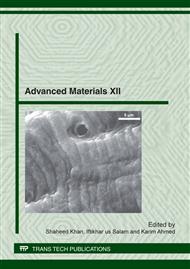p.248
p.255
p.261
p.265
p.271
p.277
p.284
p.293
p.301
Preparation and Characterization of Carbon Supported Nano-Nickel and its Sorption Behavior for Zinc from Aqueous Solutions
Abstract:
Nickel deposited on carbon has been used as adsorbent to recover Zn (II) from aqueous system. The adsorbent was synthesized by depositing nickel nitrate on carbon under inert conditions and decomposing it to nickel by raising the temperature, washing and vacuum drying. Various techniques including XRD, FTIR, and SEM were employed for its characterization. FTIR showed that the nickel deposition enhanced the carbon functionalization due to presence of OH, C=O and C-O groups.Average crystallite size ofabout 9 nm was determined from XRD. Nickel deposition resulted in further division particles as indicated from the morphological study. Zn (II) was subjected to adsorptionon the synthesized adsorbent. It was observed that the rate of adsorption increased significantly on the nickel deposited carbon than the carbon alone. Morris-Weber, Lagergren and Reichenberg models were applied to find out the type and rate of adsorption employingfirst and second order rate equations.The adsorption data were applied toLangmuir, Freundlich and D-R isotherms and values of isotherm constants were calculated and were higher for Ni/C than carbon alone. The mean free energy of zinc sorption on carbon and Ni/C are 16.67 and 18.26 kJmol-1 which shows chemisorption. Thermodynamic studies were done to find out the effect of temperature on sorption. Positive values of ΔH and negative values of ΔG show endothermic and spontaneous type of sorption.
Info:
Periodical:
Pages:
271-276
Citation:
Online since:
May 2012
Authors:
Price:
Сopyright:
© 2012 Trans Tech Publications Ltd. All Rights Reserved
Share:
Citation:


